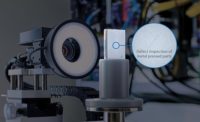An increasing number of manufacturers are turning to deep learning, a subset of artificial intelligence (AI), to assist in image analysis processing, experts say.
“There has been a significant surge in interest around AI and image analysis,” says Ed Goffin, marketing manager, Pleora Technologies.
For consumer goods manufacturing, layering AI image processing capabilities on top of existing computer vision skills can reduce false-positives, Goffin says. “Even a few percentage points of improvement significantly reduces product waste, lowers costs related to secondary screening, and increases production uptime,” he adds.
In addition, more and more organizations are seeking out image analysis tools at the operator level in applications that heavily rely on human visual skills, such as metal fabrication.
“These offline mage analysis systems can help automate inspection or make an error obvious to a human operator,” Goffin says. “A lot of these capabilities are being enabled by more powerful, scalable and flexible edge processing platforms.”
While deep learning can require a high level of expertise to implement, some organizations are partnering with SaaS software makers, hoping the package deal will appeal to OEMs that lack experience managing and annotating images, training new models, and otherwise creating deep learning inspection neural network prototypes. For example, FLIR recently partnered with software company Neurala.
“Decentralization is a major trend in image analysis for machine vision, both for users and from a system perspective,” Goffin says. “Traditionally, designing image analysis tools has been the domain of engineering experts. Artificial intelligence is changing that, with new ‘no code’ software tools that allow non-experts and end-users to develop, deploy and continuously train both machine learning and computer vision image analysis skills.”
Similarly, image analysis is typically centralized in a machine vision system, Goffin says. Industry 4.0 and Industrial Internet of Things (IIoT) initiatives rely on relocating image analysis to edge points, with smart sensors analyzing data, making local decisions, and sending processed information on to the next step in a system.
Tom Brennan, president, Artemis Vision, says that the field is trending toward PC-based tools to handle image analysis, as well as open-source and deep learning technology.
“As systems involve more tools, the need for more customized user interfaces has emerged,” Brennan says. “It’s become less and less one size fits all. There’s more that can be done and typically the client’s process and cycle time are most important, so we end up building to suit from common components, because this minimizes costs on multiples and gets the customer exactly what they need.”
Riana Sartori, senior manager, machine vision products, FLIR, says that a growing customer base of new users of machine vision cameras is coming onto the scene.
“With this growing trend of non-expert users, we are designing our cameras, software, and documentation to be more accessible,” Sartori says. “For our software, we’re focusing on the usability of the features to assist our customers new to the machine vision space.”
"Manufacturers should step back from the hype, and fully evaluate where AI can help their business."
Current Challenges
Goffin says that many in the field are focusing on the benefits of AI for image analysis. While AI (or deep learning tools) provide promise, they can only do so much.
“Manufacturers should step back from the hype, and fully evaluate where AI can help their business and really consider the total costs,” he says. “For many manufacturers, a hybrid image analysis approach that layers AI capabilities on top of proven machine vision skills lets them add advanced inspection skills without replacing infrastructure and end-user processes.”
Traditional, rules-based image analysis presents its own difficulties.
Brennan says that repeatability and correlation with hand tools or human eyes is another common challenge.
“It’s very hard to match an existing process exactly no matter how fancy the tools,” Brennan says. “It really takes an understanding of both processes to make solutions really work and a dedication to working through the details to get it right.”
Currently, too many vision systems that don’t ultimately work for the end user proliferate, he adds.
“They can’t navigate the technological differences between a manual process with human eyes and human hands and an automated process with a camera,” he says.
COVID-19’s impact has also affected the field, experts say, and not necessarily in a bad way. Sartori says that as a reaction to COVID, an increasing number of biomedical researchers are using imaging to study white blood cells. Some research methods require improved color accuracy, which has heightened an interest in biomedical imaging. Additionally, Sartori says, to ensure adherence to social distancing guidelines, companies are interested in stereovision tracking cameras to manage occupancy in retail, warehouses, and even washrooms, and thermal camera modules to measure skin temperature.
Genevieve Diesing is a contributing editor of Quality.






